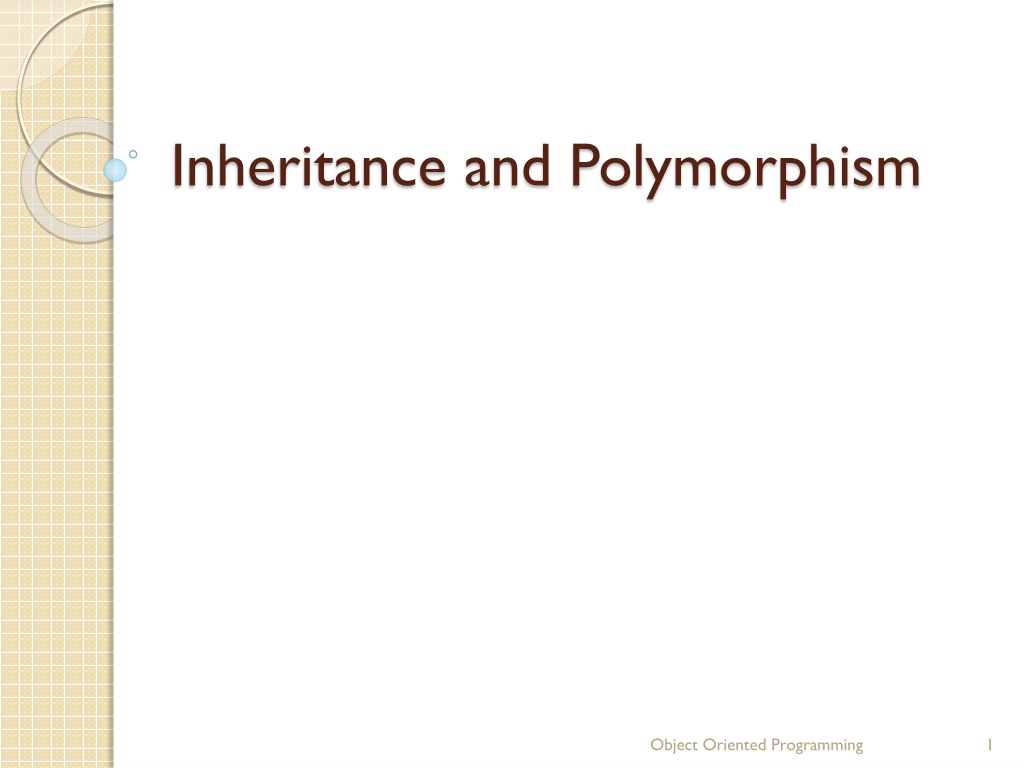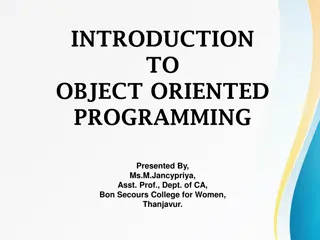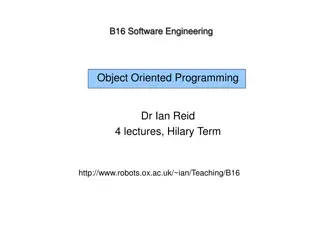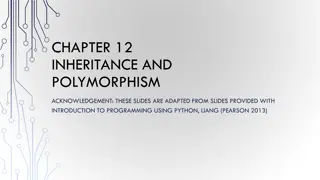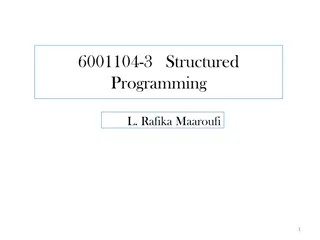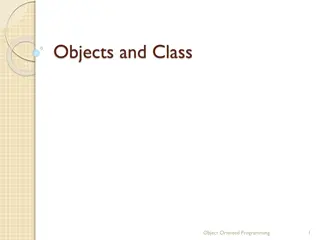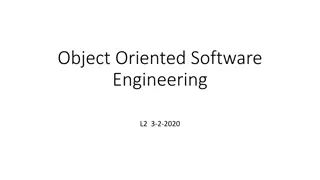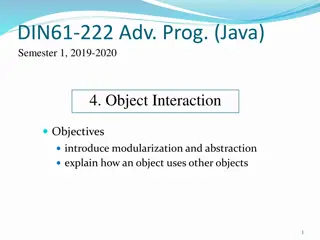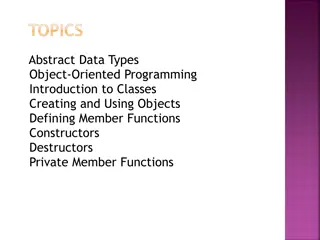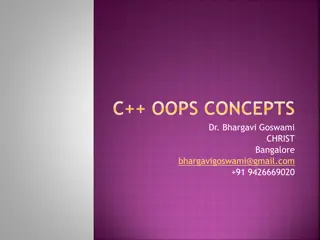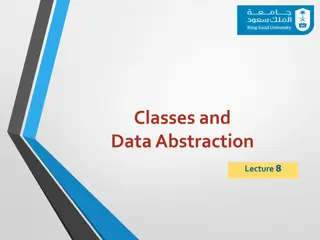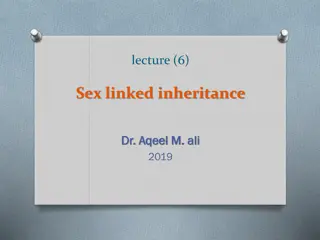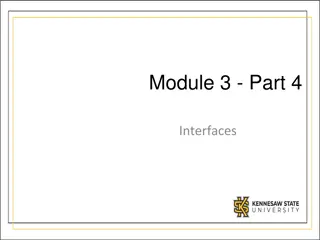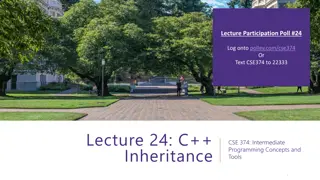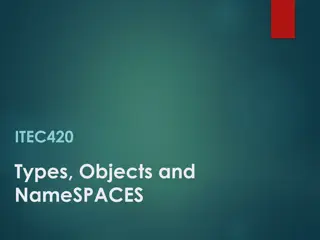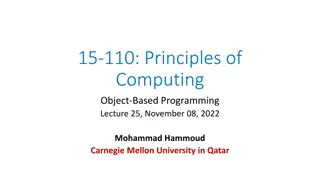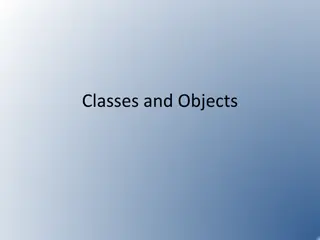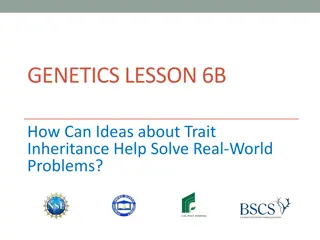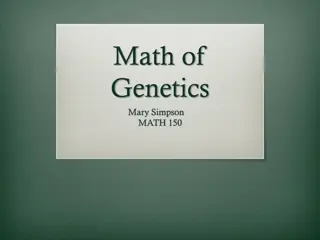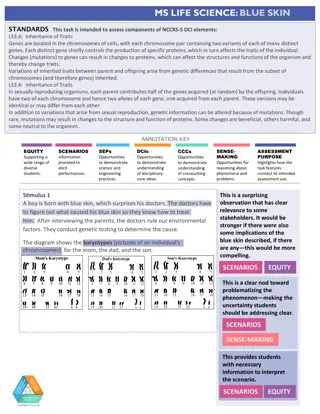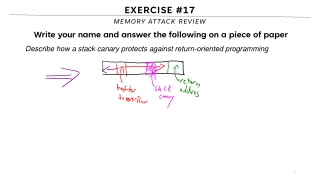Understanding Inheritance and Polymorphism in Object-Oriented Programming
Inheritance in object-oriented programming allows the creation of new classes derived from existing classes, promoting code reuse. By extending a general superclass to specialized subclasses, developers can model different entities efficiently. However, it's crucial to understand when to use inheritance effectively and when to avoid it, considering factors such as data accessibility and class relationships.
Download Presentation

Please find below an Image/Link to download the presentation.
The content on the website is provided AS IS for your information and personal use only. It may not be sold, licensed, or shared on other websites without obtaining consent from the author. Download presentation by click this link. If you encounter any issues during the download, it is possible that the publisher has removed the file from their server.
E N D
Presentation Transcript
Inheritance and Polymorphism Object Oriented Programming 1
Inheritance Object-oriented programming allows you to define new classes from existing classes. This is called inheritance. Inheritance is an important and powerful feature for reusing Suppose you need to define classes to model circles, rectangles, and triangles. These classes have many common features. software/code. Object Oriented Programming 2
Inheritance enables you to define a general class (i.e., a superclass) and later extend it to more specialized classes (i.e., subclasses). Object Oriented Programming 3
Cont. In Java terminology, a class C1 extended from another class C2 is called a subclass, and C2 is called a superclass. A superclass is also referred to as a parent class or a base class, and a subclass as a child class, an extended class, or a derived class. SimpleGeometricObject.java, CircleFromSimpleGeometricObject.java, RectangleFromSimpleGeometricObject.java, TestCircleRectangle.java Object Oriented Programming 4
Cont. Contrary to the conventional interpretation, a subclass is not a subset of its superclass. In fact, a subclass usually contains more information and methods than its superclass. Private data fields in a superclass are not accessible outside the class. Therefore, they cannot be used directly in a subclass. They can, however, be accessed/mutated through public accessors/mutators if defined in the superclass. Not all relationships should be modeled using inheritance. For example, a square is a rectangle, but you should not extend a Square class from a Rectangle class, because the width and height properties are not appropriate for a square. Instead, you should define a Square class to extend the GeometricObject class and define the side property for the side of a square. Object Oriented Programming 5
Cont. Do not blindly extend a class just for the sake of reusing methods. For example, it makes no sense for a Tree class to extend a Person class, even though they share common properties such as height and weight. Some programming languages allow you to derive a subclass from several classes. This capability is known as multiple inheritance. Java, however, does not allow multiple inheritance. A Java class may inherit directly from only one superclass. This restriction is known as single inheritance. If you use the extends keyword to define a subclass, it allows only one parent class. Object Oriented Programming 6
super keyword A subclass inherits accessible data fields and methods from its superclass. Does it inherit constructors? Can the superclass s constructors be invoked from a subclass? The keyword super refers to the superclass and can be used to invoke the superclass s methods and constructors. Object Oriented Programming 7
Calling constructor of superclass Unlike constructors of a superclass are not inherited by a subclass. They can only be invoked from the constructors of the subclasses using the keyword super. super(), or super(parameters); The statement super(arguments) must be the first statement of the subclass s constructor; this is the only way to explicitly invoke a superclass constructor. properties and methods, the super() or Object Oriented Programming 8
Construction chaining A constructor may invoke an overloaded constructor or its superclass constructor. If neither is invoked explicitly, the compiler automatically puts super() as the first statement in the constructor. Object Oriented Programming 9
Calling method of superclass The keyword super can also be used to reference a method other than the constructor in the superclass. The syntax is: super.method(parameters); It is not necessary to put super before getDateCreated() in this case, however, because getDateCreated is a method in the GeometricObject class and is inherited by the Circle class. Apple.java If possible, you should provide a no-arg constructor for every class to make the class easy to extend and to avoid errors. Object Oriented Programming 11
Overriding A subclass inherits methods from a superclass. Sometimes it is necessary for the subclass implementation of a method defined in the superclass. This is referred to as method overriding. To override a method, the method must be defined in the subclass using the same signature and the same return type as in its superclass. to modify the Object Oriented Programming 12
Cont. The toString() method is defined in the GeometricObject class and modified in the Circle class. Both methods can be used in the Circle class. To invoke the toString method defined in the GeometricObject class from the Circle class, use super.toString(). Object Oriented Programming 13
Cont. Several points are worth noting: An instance method can be overridden only if it is accessible. Thus a private method cannot be overridden, because it is not accessible outside its own class. If a method defined in a subclass is private in its superclass, the two methods are completely unrelated. Like an instance method, a static method can be inherited. However, a static method cannot be overridden. If a static method defined in the superclass is redefined in a subclass, the method defined in the superclass is hidden. The hidden static methods can be invoked using SuperClassName.staticMethodName. the syntax Object Oriented Programming 14
Output - Test1.java Object Oriented Programming 15
Overriding Vs Overloading Overloading means to define multiple methods with the same name but different signatures. Overriding means to provide a new implementation for a method in the subclass. Object Oriented Programming 16
Cont. Overridden methods are in different classes related by inheritance; overloaded methods can be either in the same class or different classes related by inheritance. Overridden methods have the same signature and return type; overloaded methods have the same name but a different parameter list. Object Oriented Programming 17
@Override annotation @Override annotation is used when we override a method in sub class. override.java Using @Override annotation while overriding a method is considered as a best practice for coding in java because of the following two advantages: 1) If programmer makes any mistake such as wrong method name, wrong parameter types while overriding, you would get a compile time error. As by using this annotation you instruct compiler that you are overriding this method. If you don t use the annotation then the sub class method would behave as a new method (not the overriding method) in sub class. 2) It improves the readability of the code. So if you change the signature of overridden method then all the sub classes that overrides the particular method would throw a compilation error, which would eventually help you to change the signature in the sub classes. If you have lots of classes in your application then this annotation would really help you to identify the classes that require changes when you change the signature of a method. Object Oriented Programming 18
Object Class and toString method Every class in Java is descended from the java.lang.Object class. Object Oriented Programming 19
Design a class named Triangle that extends GeometricObject. The class contains: Three double data fields named side1, side2, and side3 with default values 1.0 to denote three sides of the triangle. A no-arg constructor that creates a default triangle. A constructor that creates a triangle with the specified side1, side2, and side3. The accessor methods for all three data fields. A method named getArea() that returns the area of this triangle. A method named getPerimeter() that returns the perimeter of this triangle. A method named toString() that returns a string description for the triangle. The toString() method is implemented as follows: return "Triangle: side1 = " + side1 + " side2 = " + side2 + " side3 = " + side3; Write a test program that prompts the user to enter three sides of the triangle, a color, and a Boolean value to indicate whether the triangle is filled. The program should create a Triangle object with these sides and set the color and filled properties using the input. The program should display the area, perimeter, color, and true or false to indicate whether it is filled or not. Object Oriented Programming 20
Polymorphism Polymorphism means that a variable of a supertype can refer to a subtype object. First, let us define two useful terms: subtype and supertype. A class defines a type. A type defined by a subclass is called a subtype, and a type defined by its superclass is called a supertype. Therefore, you can say that Circle is a subtype of GeometricObject and GeometricObject is a supertype for Circle. A subclass is a specialization of its superclass; every instance of a subclass is also an instance of its superclass, but not vice versa. Therefore, you can always pass an instance of a subclass to a parameter of its superclass type. Object Oriented Programming 21
Static Vs Dynamic binding Connecting a method call to the method body is known as binding. There are two types of binding Static Binding (also known as Early Binding). Dynamic Binding (also known as Late Binding). Object Oriented Programming 22
Dynamic Binding A method can be implemented in several classes along the inheritance chain. The JVM decides which method is invoked at runtime. The type that declares a variable is called the variable s declared type. Here o s declared type is Object. A variable of a reference type can hold a null value or a reference to an instance of the declared type. The actual type of the variable is the actual class for the object referenced by the variable. Here o s actual type is GeometricObject, because o references an object GeometricObject(). Which toString() method is invoked by o is determined by o s actual type. This is known as dynamic binding. created using new Object Oriented Programming 23
Cont. That is, Cn is the most general class, and C1 is the most specific class. In Java, Cn is the Object class. If o invokes a method p, the JVM searches for the implementation of the method p in C1, C2, . . . , Cn-1, and Cn, in this order, until it is found. Once an implementation is found, the search stops and the first-found implementation is invoked. staticbinding.java and dynamicbinding.java Object Oriented Programming 24
Casting Objects One object reference can be typecast into another object reference. This is called casting object. DynamicBindingDemo.java m(new Student()); Object o = new Student(); // Implicit casting m(o); Suppose you want to assign the object reference o to a variable of the Student type using the following statement: Student b = o; // generate compile error Object Oriented Programming 25
Cont. Why does the statement Object o = new Student() work but Student b = o doesn t? The reason is that a Student object is always an instance of Object, but an Object is not necessarily an instance of Student. Even though you can see that o is really a Student object, the compiler is not clever enough to know it. Fruit supertype; Apple and Organe subtype Object Oriented Programming 26
Cont. To tell the compiler that o is a Student object, use explicit casting. The syntax is similar to the one used for casting among primitive data types. Student b = (Student)o; // Explicit casting Upcasting (implicit) and downcasting (explicit) Instance of operator CastingDemo.java Object Oriented Programming 27
Cont. You may be wondering why casting is necessary? The variable myObject is declared Object. The declared type decides which method to match at compile time. Using myObject.getDiameter() would cause a compile error, because the Object class does not have the getDiameter method. Object Oriented Programming 28
Cont. Why not define myObject as a Circle type in the first place? To enable generic programming, it is a good practice to define a variable with a supertype, which can accept an object of any subtype. Object Oriented Programming 29
Casting primitive type Vs reference type Casting a primitive type value is different from casting an object reference. Casting a primitive type value returns a new value. For example: Object Oriented Programming 30
ex_11.java VirtualDemo.java Object Oriented Programming 31
Objects equal method Like equals(Object) method is another useful method defined in the Object class. public boolean equals(Object o) This method tests whether two objects are equal. (This implementation checks whether two reference variables point to the same object using the == operator) The syntax for invoking it is: object1.equals(object2); the toString() method, the Object Oriented Programming 33
Cont. You should override this method in your custom class to test whether two distinct objects have the same content. The equals method is overridden in many classes in the Java API, such as java.lang.String and java.util.Date, to compare contents of two objects are equal. The equals method in the String class is inherited from the Object class and is overridden in the String class to test whether two strings are identical in content. Circle_equals.java whether the Object Oriented Programming 34
Protected data and methods A protected member of a class can be accessed from a subclass. Often it is desirable to allow subclasses to access data fields or methods defined in the superclass, but not to allow non-subclasses to access these data fields and methods. The modifiers private, protected, and public are known as visibility or accessibility modifiers because they specify how classes and class members are accessed. Object Oriented Programming 35
Cont. Your class can be used in two ways: (1) for creating instances of the class and (2) for defining subclasses by extending the class. Make the members private if they are not intended for use from outside the class. Make the members public if they are intended for the users of the class. Make the fields or methods protected if they are intended for the extenders of the class but not for the users of the class. The private and protected modifiers can be used only for members of the class. The public modifier and the default modifier (i.e., no modifier) can be used on members of the class as well as on the class. Object Oriented Programming 37
Preventing extending or overriding You may occasionally want to prevent classes from being extended. public final class A { } You also can define a method to be final; a final method cannot be overridden by its subclasses. Object Oriented Programming 39
Abstract Class In the inheritance hierarchy, classes become more specific and concrete with each new subclass. If you move from a subclass back up to a superclass, the classes become more general and less specific. Class design should ensure that a superclass contains common features of its subclasses. Sometimes a superclass is so abstract that it cannot be used to create any specific instances. Such a class is referred to as an abstract class. TestGeometricObject.java Object Oriented Programming 40
Cont. An abstract method cannot be contained in a nonabstract class. If a subclass of an abstract superclass does not implement all the abstract methods, the subclass must be defined as abstract. In other words, in a nonabstract subclass extended from an abstract class, all the abstract methods must be implemented. Also note that abstract methods are nonstatic. An abstract class cannot be instantiated using the new operator, but you can still define its constructors, which are invoked in the constructors of its subclasses. For instance, the constructors of GeometricObject are invoked in the Circle class and the Rectangle class. A class that contains abstract methods must be abstract. However, it is possible to define an abstract class that doesn t contain any abstract methods. In this case, you cannot create instances of the class using the new operator. This class is used as a base class for defining subclasses. Object Oriented Programming 41
Cont. A subclass can be abstract even if its superclass is concrete. For example, the Object class is concrete, but its subclasses, such as GeometricObject, may be abstract. You cannot create an instance from an abstract class using the new operator, but an abstract class can be used as a data type. Therefore, the following statement, which creates an array whose elements are of the GeometricObject type, is correct. GeometricObject[] objects = new GeometricObject[10]; You can then create an instance of GeometricObject and assign its reference to the array like this: objects[0] = new Circle(); Object Oriented Programming 42
Why abstract methods? You may be wondering what advantage is gained by defining getArea() and getPerimeter() as abstract in the GeometricObject class. Note that you could not define the equalArea method whether two geometric objects have the same area if the getArea method were not defined in GeometricObject. the methods for comparing Object Oriented Programming 43
Abstract method must be inside abstract class It should be public abstract class A and it does not have body Abstract method must be inside abstract class legal legal legal Object Oriented Programming 44
Program Design a new Triangle class that extends the abstract GeometricObject class and then implement the Triangle class. Write a test program that prompts the user to enter three sides of the triangle, a color, and a Boolean value to indicate whether the triangle is filled. The program should create a Triangle object with these sides and set the color and filled properties using the input. The program should display the area, perimeter, color, and true or false to indicate whether it is filled or not. Object Oriented Programming 45
Interfaces An interface is a class-like construct that contains only constants and abstract methods. In many ways an interface is similar to an abstract class, but its intent is to specify common behavior for objects of related classes or unrelated classes. Using interface, you can specify what a class must do, but not how it does it. Object Oriented Programming 46
Cont. Interfaces are syntactically similar to classes, but they lack instance variables, and, as a general rule, their methods are declared without any body. In practice, this means that you can define interfaces that don t make assumptions about how they are implemented. An interface is treated like a special class in Java. Each interface is, just like a regular class. compiled into a separate bytecode file You can use an interface as a data type for a reference variable, as the result of casting, and so on. As with an abstract class, you cannot create an instance from an interface using the new operator. Object Oriented Programming 47
Cont. Variables are implicitly final and static, meaning they cannot be changed by the implementing class. They must also be initialized. All methods and variables are implicitly public. interface_1.java Object Oriented Programming 48
Accessing implementation through interface reference You can declare variables of interface as object references that use an interface rather. Any instance of any class that implements the declared interface can be referred to by such a variable. When you call a method through one of these references, the correct version will be called based on the actual instance of the interface being referred to. This is one of the key features of interfaces. interface_2.java and interface_3.java Object Oriented Programming 49
Variables in interface You can use interfaces to import shared constants into multiple classes by simply declaring an interface that contains variables that are initialized to the desired values. Implementing class does not implement any method. It is as if that class were importing the constant fields into the class name space as final variables. Object Oriented Programming 50
